What do today’s top-performing brands—from lean startups to legacy enterprises—have in common? A rock-solid content marketing strategy. In a digital ecosystem flooded with automation, AI tools, and short-lived trends, content remains one of the few marketing assets that builds long-term value. But the way we approach content has changed. In 2025, it’s not just about publishing blogs or posting on social media—it’s about crafting a strategic, scalable content engine that attracts, engages, and converts across every stage of the customer journey.
At NetLZ Consulting, we’ve seen firsthand how businesses in New Jersey and beyond are transforming their online presence with content that’s not only search-optimized but genuinely helpful. Whether you’re looking to increase organic traffic, boost lead generation, or drive sales through storytelling, this guide breaks down what a successful content marketing strategy looks like in 2025—and how your business can build one that actually works. We’ll walk you through the core components, latest trends, and proven tactics used by high-performing teams today.
What Is a Content Marketing Strategy?
A content marketing strategy is more than just a publishing schedule or a list of blog ideas—it’s a long-term blueprint for creating and distributing valuable, relevant, and consistent content to attract and retain a clearly defined audience. At its core, the strategy is about aligning your content efforts with business objectives, customer needs, and digital behavior patterns.
In 2025, an effective content strategy includes audience segmentation, keyword-informed content planning, platform-specific distribution, and performance analytics—all driven by a deep understanding of your market. It’s a proactive, data-informed approach that turns content into a growth asset rather than a one-off task.
Whether you’re running a B2B SaaS company, an ecommerce store, or a local service-based business in New Jersey, a well-executed content marketing strategy helps build brand authority, foster trust, and generate inbound traffic that compounds over time.
Why Is Content Marketing Important in 2025?
The digital marketing landscape in 2025 is more saturated—and more sophisticated—than ever before. With the rise of AI-generated content, hyper-personalized advertising, and evolving consumer privacy expectations, businesses are competing not just for attention but for trust.
That’s where a strategic content marketing approach becomes indispensable. Unlike paid ads that vanish when budgets run out, content marketing creates a library of evergreen assets that continue to attract, educate, and convert over time. More importantly, the right content builds authority in your niche, positions your brand as a reliable resource, and nurtures long-term customer relationships in a way no ad campaign can replicate.
We’ve partnered with businesses across New Jersey and the U.S. who are tired of chasing algorithm updates and want a marketing strategy with staying power. In 2025, we’re seeing that content marketing isn’t just a nice-to-have—it’s the foundation for everything else. Your SEO success depends on the quality and relevance of your content. Your email campaigns are only as strong as the stories and value they deliver.
What Are the Key Components of a Successful Content Marketing Strategy?
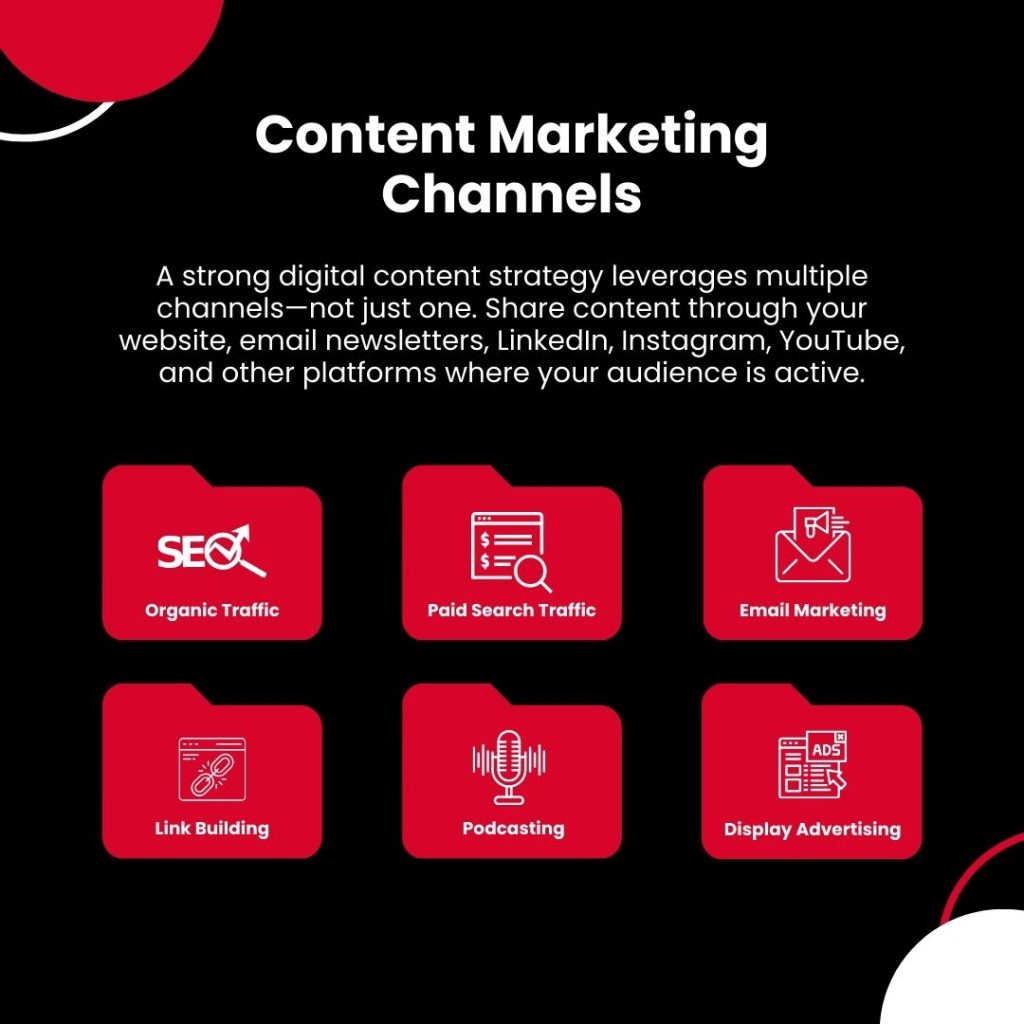
To build an effective content marketing strategy in 2025, businesses must go beyond simply creating content—they need a structured, goal-driven framework that ties every piece of content to business growth. A successful strategy includes clear objectives, deep audience understanding, optimized content creation, targeted distribution, and ongoing performance analysis. These foundational components help ensure your content reaches the right people, at the right time, on the right platforms.
1. Define Clear Objectives
Establish specific, measurable, achievable, relevant, and time-bound (SMART) goals. Whether it’s increasing brand awareness, generating leads, or boosting sales, clear objectives guide your content efforts.
2. Understand Your Audience
Conduct thorough research to identify your target audience’s needs, preferences, and pain points. Utilize tools like surveys, interviews, and analytics to gather insights.
3. Content Creation and Distribution
Develop high-quality, relevant content tailored to your audience. Diversify content formats, including blogs, videos, podcasts, and infographics. Distribute content across appropriate channels, such as social media, email newsletters, and your website.
4. SEO Optimization
Implement SEO best practices to enhance content visibility. This includes keyword research, optimizing meta tags, and ensuring mobile-friendliness. An effective SEO content marketing strategy increases organic traffic and improves search engine rankings.
5. Performance Measurement
Regularly analyze content performance using key performance indicators (KPIs) like website traffic, engagement rates, and conversion metrics. Use these insights to refine your strategy continuously.
What Are the Top Content Marketing Trends to Watch in 2025?
Staying ahead in 2025 means adapting your content marketing strategy to reflect new tools, behaviors, and platforms. From AI personalization to voice search, today’s top trends are reshaping how brands connect with their audiences. Understanding these shifts—and integrating them into your plan—can help you create content that’s more engaging, discoverable, and conversion-driven than ever before.
AI-Driven Personalization
Artificial intelligence enables marketers to deliver personalized content experiences at scale. By analyzing user behavior and preferences, AI can tailor content recommendations, improving engagement and conversion rates.
Voice Search Optimization
With the increasing use of voice assistants, optimizing content for voice search is crucial. This involves focusing on natural language, question-based queries, and concise answers to improve visibility in voice search results.
Interactive Content
Interactive elements like quizzes, polls, and calculators enhance user engagement. They provide value to users while collecting valuable data for marketers.
Short-Form Video Content
Platforms like TikTok and Instagram Reels have popularized short-form videos. These bite-sized content pieces are effective for capturing attention and conveying messages quickly.
B2B Content Marketing Strategy
In B2B contexts, content marketing focuses on building relationships and establishing authority. Strategies include creating in-depth whitepapers, case studies, and hosting webinars to educate and engage business clients.
How to Create a Content Marketing Strategy
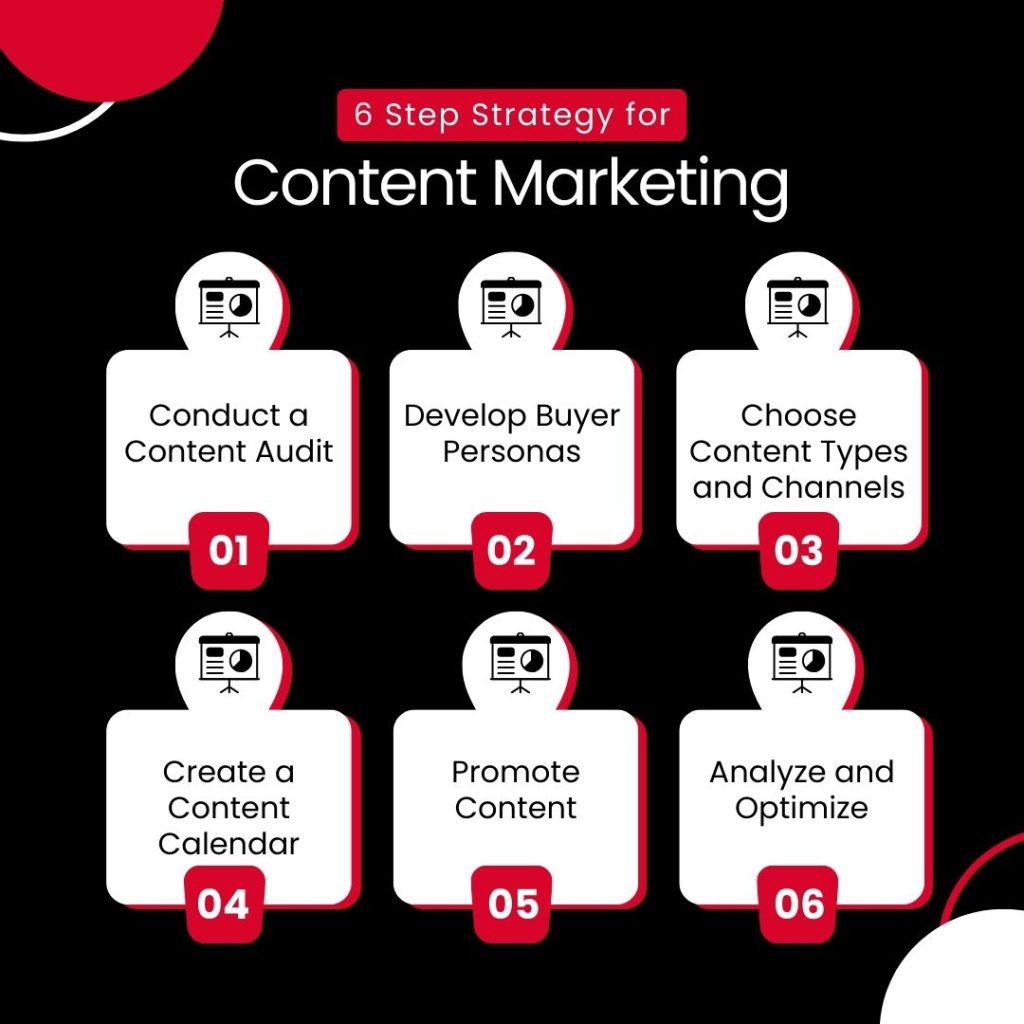
Creating a successful content marketing strategy requires more than good ideas—it takes a clear process, structured planning, and the ability to align every piece of content with specific business outcomes. Whether you’re starting from scratch or refining an existing strategy, following a step-by-step approach helps ensure your content efforts are intentional, measurable, and impactful. Here’s how to build a strategy that drives real results in 2025.
Step 1: Conduct a Content Audit
Evaluate existing content to identify what’s performing well and where gaps exist. This helps in understanding what content resonates with your audience and informs future content creation.
Step 2: Develop Buyer Personas
Create detailed profiles representing your ideal customers. Include demographics, challenges, goals, and content preferences to guide content development.
Step 3: Choose Content Types and Channels
Select content formats and distribution channels that align with your audience’s preferences and behaviors. For instance, if your audience prefers visual content, focus on videos and infographics shared on platforms like YouTube and Instagram.
Step 4: Create a Content Calendar
Plan content topics, formats, and publication dates in advance. A content calendar ensures consistency and helps in aligning content with marketing campaigns and product launches.
Step 5: Promote Content
Utilize various channels to distribute and promote your content. This includes social media, email marketing, and partnerships with influencers or other brands.
Step 6: Analyze and Optimize
Regularly review content performance metrics to assess effectiveness. Use these insights to optimize future content, improve engagement, and achieve better results.
What Is Content Repurposing and Why Does It Matter?
Repurposing content is a key tactic in modern content marketing strategies, especially in 2025, when attention is fragmented across platforms. Content repurposing means taking one core asset, such as a blog post or webinar, and turning it into multiple pieces of content for different channels. This not only helps reinforce messaging but also maximizes your content investment and reach.
Increase Content ROI
Repurposing reduces the need to constantly produce from scratch. A single webinar can become blog posts, quote graphics, video clips, and email sequences—saving time and multiplying value.
Reach Users on Multiple Platforms
Your audience consumes content differently on each platform. Repurposing allows you to tailor the format, like turning a blog into an Instagram carousel or a TikTok-style video, to where your audience already is.
Reinforce Core Messaging
Repetition builds brand authority and recognition. Sharing variations of the same message across formats reinforces your positioning and increases retention.
Improve SEO Performance
Repurposed content, especially when interlinked, strengthens your internal SEO architecture and creates multiple opportunities to rank for related queries.
How Does SEO Fit into a Content Marketing Strategy?
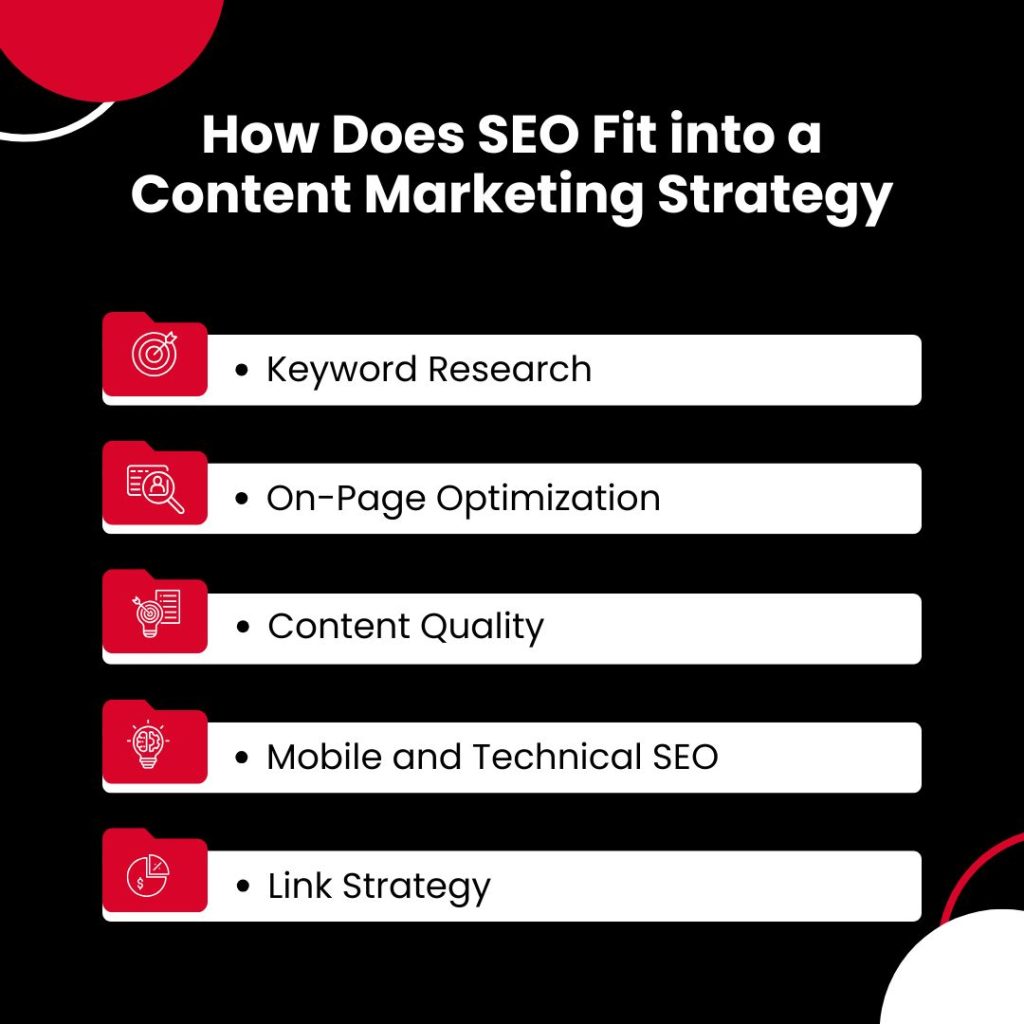
SEO is the engine behind content visibility. No matter how great your content is, it won’t drive traffic if people can’t find it—and in 2025, that means optimizing every piece with search intent in mind. A strong SEO content marketing strategy blends informative, user-focused content with technical best practices to ensure your site ranks, engages, and converts. It’s no longer enough to post content consistently—you need to post strategically. That means using data to guide what you publish, optimizing it for how people search, and structuring it to perform well across search engines and devices.
Keyword Research
A solid SEO foundation begins with understanding what your audience is actively searching for. Go beyond basic keywords and focus on intent-driven phrases, voice search queries, and long-tail keywords that mirror how users naturally speak or ask questions. Use tools like SEMrush, Ahrefs, and Google Search Console to uncover search volume, keyword difficulty, and trending topics. This insight should guide not just the content topic, but also how it’s framed, titled, and structured.
On-Page Optimization
Each piece of content should be optimized from top to bottom. That includes your title tags, meta descriptions, headers (H1s, H2s, H3s), URL slugs, image alt text, and internal links. Use your target keyword early and naturally in the content. Structure pages to be skimmable, with short paragraphs and clear subheaders. Optimize for snippet eligibility by using bullet points, FAQ sections, and clear definitions at the top of the page.
Content Quality
Google’s algorithms are constantly evolving to reward content that is accurate, valuable, and experience-driven. Your goal should be to create content that demonstrates Experience, Expertise, Authoritativeness, and Trustworthiness (E-E-A-T). This means including author credentials when applicable, citing trustworthy sources, and covering topics in enough depth to satisfy the user’s intent. Thin or shallow content not only underperforms—it may also hurt your site’s overall domain trust.
Mobile and Technical SEO
Search engines now prioritize mobile-first indexing. If your content loads slowly, doesn’t render properly on mobile, or has technical errors like broken links or poor schema markup, your rankings will suffer, regardless of how good the content is. Use tools like PageSpeed Insights and Mobile-Friendly Test to audit your content regularly. Make sure your website is structured for easy crawling and indexing, with logical navigation, clean URLs, and a secure HTTPS protocol.
Link Strategy
Internal linking helps search engines understand your site structure and keeps users moving through your content. Use descriptive anchor text and connect related blog posts, service pages, and pillar content. Equally important is external linking—earning backlinks from reputable websites signals authority and trust. Build relationships with industry partners, contribute guest content, and create resources that naturally attract links.
What Is a Digital Content Marketing Strategy?
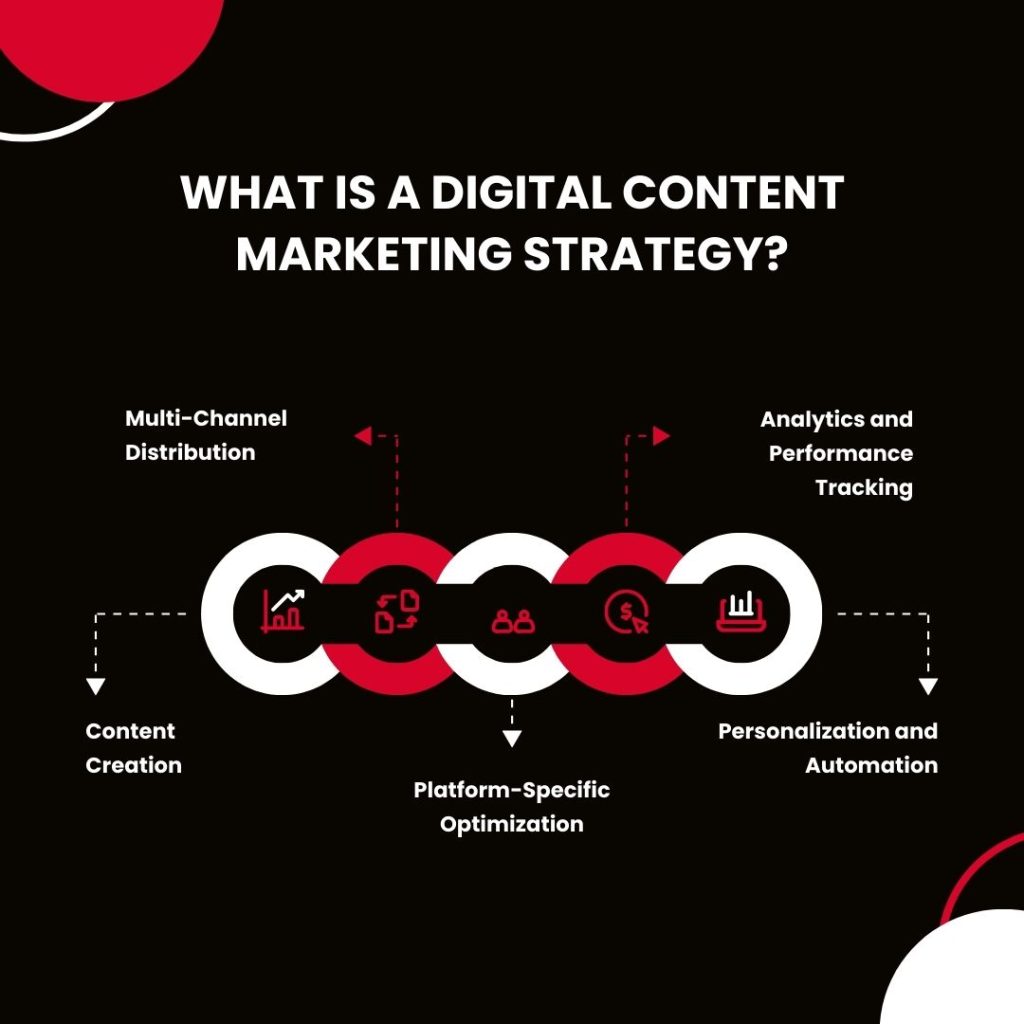
A digital content marketing strategy is your blueprint for creating, publishing, and distributing content across online platforms to drive traffic, generate leads, and convert customers. In 2025, this strategy must account for how content performs across search engines, social media, email, and even emerging platforms like AI-driven feeds.
It’s not just about posting blogs—it’s about building a multi-channel content ecosystem that reflects your brand, supports your sales funnel, and meets users where they are. Whether you’re a local business in New Jersey or an ecommerce company with a national audience, your digital content strategy determines how your brand is discovered and experienced online.
Content Creation
Plan content that aligns with your brand voice and goals while addressing your audience’s real questions and needs. Use a mix of long-form blogs, videos, infographics, and downloadable assets to support different stages of the buyer journey. Incorporate SEO best practices and maintain a consistent publishing schedule.
Multi-Channel Distribution
A strong digital content strategy leverages multiple channels, not just one. Share content through your website, email newsletters, LinkedIn, Instagram, YouTube, and other platforms where your audience is active. Each channel should be tailored in tone, format, and delivery to fit its audience and context.
Platform-Specific Optimization
Tailor your content for each platform’s algorithm and user behavior. For example, short-form vertical video performs best on TikTok and Instagram Reels, while in-depth articles with internal links perform better on your website or LinkedIn. Repurpose content so the same idea can be used in multiple formats without sounding repetitive.
Analytics and Performance Tracking
Use digital tools like Google Analytics 4, HubSpot, and social media dashboards to track which content formats and channels deliver the highest ROI. Evaluate KPIs like bounce rates, time on page, conversion rates, and click-through rates to refine your strategy over time.
Personalization and Automation
Use customer data to personalize email content, landing pages, and website recommendations. Automate delivery using CRM tools and marketing automation platforms to nurture leads with timely, targeted content based on their behavior and interests.
What Is a Content Marketing Strategy for Ecommerce?
An effective e-commerce content marketing strategy goes beyond product listings—it creates an entire ecosystem of content that educates, builds trust, and drives sales. In 2025, ecommerce brands face stiff competition not only from other retailers but from marketplaces, subscription services, and even social commerce platforms.
That’s why a comprehensive strategy must be built to attract potential buyers through organic search, nurture them through compelling storytelling, and convert them with relevant, well-timed content. The goal is to turn your site into more than just a store—it should be a destination for answers, solutions, and inspiration.
Product Guides and Tutorials
Create in-depth buying guides, how-tos, and comparison posts that help shoppers make informed decisions. These pieces position your brand as a trusted advisor and reduce friction in the buying process.
SEO-Optimized Product Pages
Your product descriptions should be more than just specs. Use unique, keyword-rich content that addresses search intent, includes FAQs, and improves visibility on Google Shopping and traditional search results.
Customer Reviews and UGC
Encourage and showcase user-generated content like reviews, testimonials, and unboxing videos. These build credibility and offer social proof, especially for first-time buyers.
Blog Content
Publish regular blog articles on topics relevant to your products, lifestyle niche, or customer base. Answer common questions, highlight product use cases, or feature customer success stories. Each blog is an opportunity to rank for long-tail keywords and drive inbound traffic.
Email Marketing
Use content to fuel ecommerce email campaigns, such as abandoned cart sequences, product education series, or seasonal gift guides. Personalize based on past behavior, purchase history, and browsing activity.
Social Media Integration
Promote blog posts, video tutorials, and behind-the-scenes content on platforms like Instagram, TikTok, and Pinterest. These channels support brand discovery and can drive both immediate purchases and long-term loyalty.
What Are the Benefits of Hiring a Content Marketing Specialist?
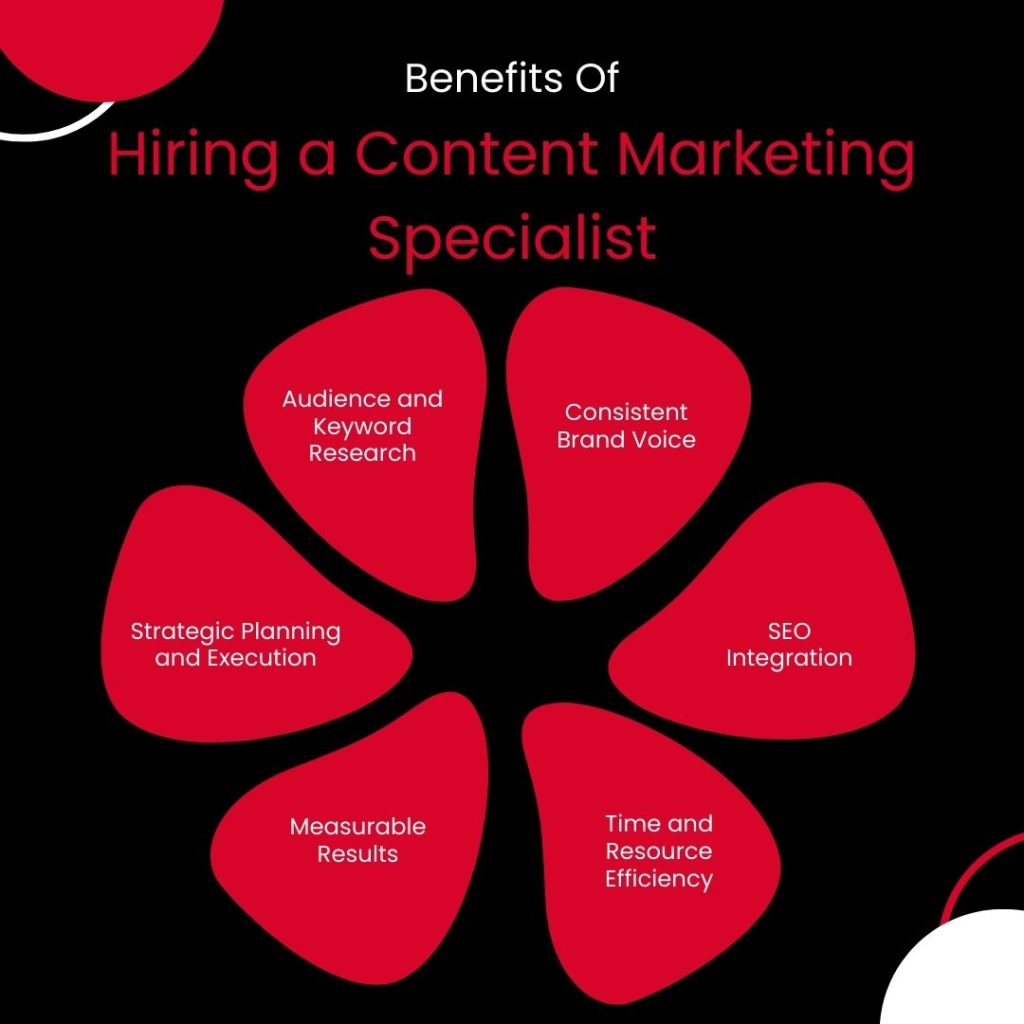
A content marketing specialist brings more than just writing skills—they offer a strategic, data-driven approach that turns content into a business asset. In 2025, when search algorithms, platforms, and user behaviors evolve constantly, having a dedicated professional ensures your content marketing strategy stays relevant, effective, and aligned with your business goals. Whether you’re a growing ecommerce store or a local business exploring digital marketing services in NJ, the benefits of hiring a content expert can impact every stage of your online growth.
Strategic Planning and Execution
A content marketing specialist understands how to map content to each phase of the buyer journey. They can create a strategy that blends blog posts, landing pages, email campaigns, and SEO-focused assets into one cohesive plan, not random posts or filler content.
Audience and Keyword Research
Professionals use keyword tools, search trend data, and competitor analysis to uncover what your target audience is searching for. This helps guide your SEO content marketing strategy, ensuring content speaks to user intent and drives organic traffic.
Consistent Brand Voice
Hiring a specialist ensures your content maintains a consistent tone across platforms—from social media to email to your website. This strengthens your brand identity and improves trust, especially in competitive markets.
SEO Integration
Every piece of content should support your SEO goals. A content marketing specialist understands how to optimize on-page elements (titles, headers, alt text), structure articles for featured snippets, and interlink content in a way that improves crawlability and site authority.
Measurable Results
A skilled specialist tracks performance using KPIs like traffic, engagement, click-through rates, and conversions. They don’t just create content—they analyze what works and adjust your approach to improve ROI over time.
Time and Resource Efficiency
Instead of managing everything in-house, hiring a specialist allows your team to focus on operations while content creation, optimization, and publishing are handled by someone who knows what they’re doing. This saves time and helps avoid costly trial and error.
How Does Content Strategy Differ Across Industries?
A one-size-fits-all content strategy doesn’t work—and in 2025, that’s more true than ever. Different industries require tailored approaches based on buying cycles, user intent, and regulatory sensitivity.
B2B and IT
These industries often need technical, educational content like whitepapers, webinars, and in-depth guides to support long sales cycles and demonstrate expertise.
Medical and Dental
Content must be accurate, trustworthy, and compliant with HIPAA or industry regulations. FAQs, service pages, and patient education blogs are especially effective.
Law Firms
Legal content should balance clarity with authority. Practice area pages, case results, and answers to common legal questions help build credibility and local SEO strength.
Home Care and Local Services
These audiences often rely on personal trust. Testimonials, service explainers, and compassionate storytelling perform well, especially when optimized for “near me” searches.
How to Take the Next Step with Your Content Marketing Strategy in 2025
If there’s one thing 2025 has made clear, it’s that content isn’t just part of a marketing plan—it is the marketing plan. From search visibility to lead nurturing and conversion, a well-executed content marketing strategy supports every layer of your digital presence. Whether you’re a small business owner, a B2B marketer, or an e-commerce brand, investing in a strategic, SEO-driven content plan ensures you’re not just creating content, but creating content that works.
The key is to approach content marketing with intention. Know your audience. Build around search intent. Optimize for every device and channel. And above all, treat content as a long-term investment, not a one-time project. With a clear strategy, the right team or tools in place, and a commitment to consistency, your content can drive real, measurable growth—far beyond likes or pageviews.
Resources:
- How to Create a Content Marketing Plan in 7 Steps – Semrush
- 40+ Content Marketing Trends Experts Predict Will Matter for Success in 2025 – Content Marketing Institute
- Content marketing in 2025: 6 strategies you can’t ignore – Search Engine Land

